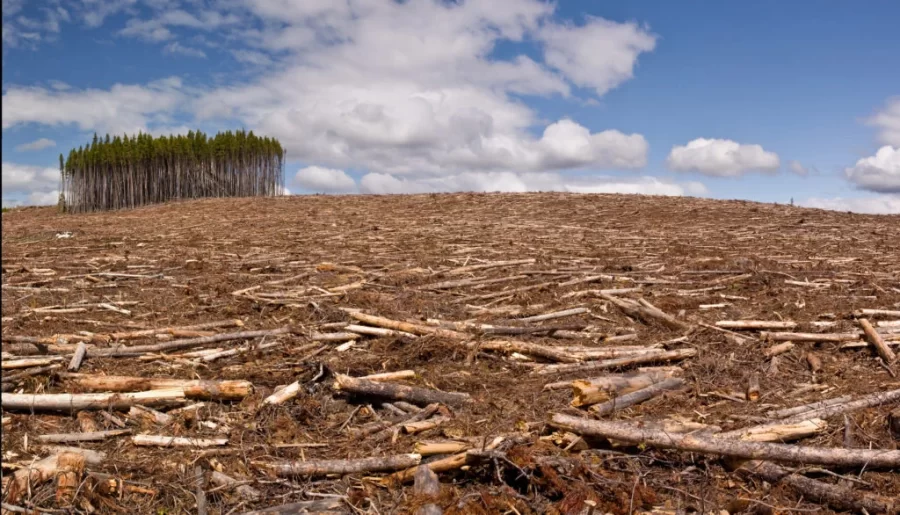Deforestation and it’s gradual dismantling of Earth’s forests, wildlife, and temperature regulation
May 9, 2023
When I attempt to define Democracy, I typically initially think of choice. Our individual rights to contribute to what the government and governing powers attempt to surround us with; laws, buildings, regulations, etc etc. I believe local and global say on natural beauty and its aid to humans have gone without much say from the public, notwithstanding the detrimental effects that follow inadequate action. Ultimately, this has appeared to allow governments and construction agencies to manipulate our forests and wildlife freely, selfishly and negligently, without properly replacing what was removed.
The troves of trees and wildlife I have recently noticed removed from Maple Valley and the greater Seattle area has been of great concern to me recently, and made me ponder what this may look like on a greater scale nationally and globally. I often hear silent protests from local citizens about the pleasant nature we’ve grown accustomed to removing against our will. They say nature is arguably Washington’s, and Maple Valley’s, most redeeming trait. It even is a significant factor in choosing to live here, as well.
What I’ve generally garnered from these discussions is a sense of pride among locals who rave about the natural beauty of our area – to them, it’s something we possess that isn’t replicable elsewhere, providing our own unique personality that acts as a voice of its own. One of those individuals is Carolina Mozo, who once lived in Mexico, which is generally dry and without much forest, appreciates the scenic area we live in: “it’s refreshing, nice to look out, and makes us stand out among the rest of the country”.
However, the repercussions of mass deforestation don’t stop at the loss of scenic value (though it does harm property value). Deforestation may soon be, and arguably already is, the largest contributor to both the loss of habitat and species extinction, along with C02 emissions and the inability to regulate temperature.
Annually, a staggering approximately 15 billion trees are removed, roughly 10 million hectares. For perspective, the Amazon Rainforest, which accounts for about ⅓ of the world’s tropical rainforest, is worth 490 million hectares. At our current rate, the entire Amazon Rainforest will cease to exist at or within 49 years, not even accounting for its previous damages.
The loss of exponential rainforest additionally devastates wildlife. Due to deforestation, 137 species of plants and animals are lost each day, totalling an extinction number of 50,000 annually.
Habitats are being destroyed, leaving beyond no homes for occupancy of animals and plantlife. Up to 28,000 total species are projected to go extinct within the next quarter century alone, and will continue to exponentially rise as more habitat is destroyed.
More threatening to humans directly, though, is the impacts the absence of these trees have on our climate and atmosphere, and food production,
Trees are the Earth’s largest producer of oxygen, with a singular large one providing enough oxygen sufficient for a day for four people. Moreover, CO2 is stored in their fibers, effectively cleaning the air and acting as a massive filter for our atmosphere. Annually, the average tree will absorb more than 48 pounds of carbon dioxide.
Summatively, our forests are absolutely essential to maintaining a healthy atmosphere and stable climate. Removing several hectares of trees per year is substantially decreasing the Earth’s ability to create oxygen and filter out CO2 emissions, furthering the suffocation of our climate and leading to vast instability. The 4.8 billion tons of carbon dioxide that are emitted by deforestation annually dwarfs the number produced by automobiles, at 617 million.
What follows is a diminished ability to stabilize global temperatures, along with a lack of oxygen. Maple Valley won’t be the only ones dealing with these consequences.
Trees also play a pivotal part in the cycle of water, pulling water out through the ground through their roots and releasing it into the air as water vapor, eventually turning into rain, falling back down to ground level, and continuing the cycle.
Deforestation weakens this process, by reducing the amount of water vapor released into the atmosphere, leading to irregular rainfall patterns, including droughts and flooding. “It harms flood control greatly” says Clair Nance.
This could potentially result in a decrease of rainfall in the U.S. midwest alone by 5-35%. Wet season rainfall globally, also, is as much as 0.6 millimeters lower for every percentage point of forest clearing. This means less water availability around the globe, and will affect the agricultural outputs as well, directly harming the food supply.
Excessive Deforestation in Maple Valley is harmful and disappointing in itself, but when considering the global scale on the issue, it becomes vastly more dangerous. At the current rate, governments globally will soon be forced to acknowledge the detrimental consequences our planet will face as a result of depleted rainforests before many of the outcomes are irreversible.



